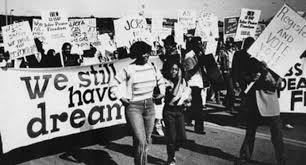Forty years ago yesterday, a bike shop was closed for, possibly, the best reason any shop could have been closed on a Saturday during the summer—on the last weekend before Labor Day, no less.
How do I know about that closure? I worked in that shop. In fact, the day before was my last day there.
On 27 August 1983, I accompanied the shop’s owner, his soon-to-be wife and a bunch of our friends and customers on a chartered bus from New Brunswick, New Jersey to Washington, D.C. The purpose of the trip? To join many, many more people in commemorating the 20th anniversary of the March on Washington: the one that includes Martin Luther King Jr.’s “I have a dream” speech.
Actually, the anniversary was the day after our trip—a Sunday. But that didn’t make a difference to those of us who participated—and those who supported us.
Among those supporters were, not surprisingly, Black city residents who gave us sandwiches, snacks, fruit, water, coffee, tea, juice, sun visors and other things that helped us on a typically hot, humid day. I couldn’t help but to wonder how many of them were there—or marched—during the original rally, which took place a few weeks after I turned five. (OK, you can do the math, if you are so inclined!)
Today, on the sixtieth anniversary of the March—and the day after the fortieth anniversary of the best shop closure in history—I can’t help but to wonder how many of the people I saw that day, let alone how many marched in the original gathering, are still alive. To the best of my knowledge, the shop’s owner—Frank Chrinko—and Wendy Novak, the woman who would become his wife, are still very much with us—and should be lauded for having the best reason to close Highland Park Cyclery on a day when, I think, they could have made a decent amount of coin.





